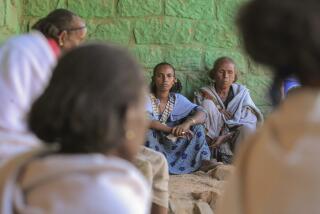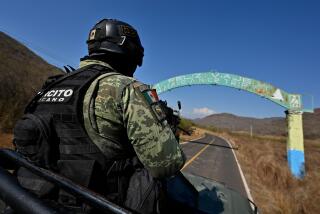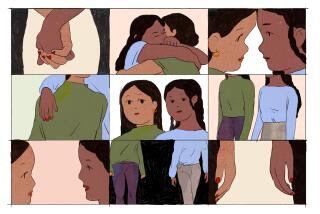Eritrean Rebel Campaign Backed by Hidden Factories, Ethiopian POWs
AROTA, Ethiopia â It is 11 p.m. White-coated technicians shuffle in surgical clogs from tubes to beakers, inspecting the quality of anti-tuberculosis pills rattling out of a molding machine at a rate of 40,000 per hour.
This isnât the late shift. It is the only shift at âEPLF Pharmaceuticals,â a lab housed inside four giant shipping crates 300 miles from the nearest independent electricity supply.
Outside in a remote valley in Eritrea in northern Ethiopia, crickets and frogs join buzzing mosquitoes and the noise of foxes chasing African hares over the boulders. Civet cats and gray owls watch from stunted, moonlit trees.
Inside, technicians of the Eritrean Peopleâs Liberation Front produce no less than 37 varieties of pills, capsules, ointments and liquids to be packed into brown bottles marked âEPLF Drug Production and Researchâ over a logo of a cobra wrapped round a pharmacistâs pestle.
The 5-year-old drug venture is just one of many backup industries supporting the EPLFâs 27-year-old guerrilla war for independence from Ethiopia. They produce souped-up automobile engines, machine tools, truck bodies, molded shoes, textbooks, pamphlets, flour-milling machines, macaroni, spaghetti and even sanitary towels.
Safety of Darkness
Like the watch and electrical repair shops and the tank and truck garages, they are heavily camouflaged and operate under the safety of darkness, free of the threat of bombardment from Ethiopian MIG warplanes.
All are staffed by trained personnel, many graduates, working without salary as their contribution to the massive, centralized war effort.
The pharmaceutical factory is the centerpiece of the key EPLF doctrine of self-reliance and self-sufficiency, forced on it by years of isolation from external support.
Basic chemicals are imported from Europe to make a range of the most frequently used preparations against diseases such as malaria and tuberculosis. The EPLF factories produce about 40% of the basic list of 187 EPLF-approved drugs covering tetracycline antibiotics, sulfanilamides, vitamins, iron supplements, anti-parasitic, paracetamol and aspirin compounds.
Even limited current production is reckoned to be worth more than $750,000 a year--$310,000 in sterile solutions for drips and major surgery alone.
More Shipping Containers
Plans are afoot to boost capacity--with the aid of more shipping containers and plentiful mud--to 80% of total drug needs.
The laboratory and its integrated research department, run by an Eritrean pharmacist trained in Ethiopia and the United States, is hidden conveniently close to the EPLFâs main hospital at Arota in northern Eritrea.
The hospital is a huge complex, able to treat 800 to 1,000 patients in small units dug into rock, camouflaged and spaced for safety along 5 miles of narrow valley. It links a network of provincial hospitals, civilian clinics and medic stations concealed near the battle fronts.
About 99% of EPLF, civilian and Ethiopian prisoner casualties can be treated for almost every kind of ailment and wound in this health system.
Neighboring valleys hold mechanical and electrical shops equipped with lathes and specialist machinery to service and substitute even the heaviest industrial plant for both civilian and military needs. That includes giant generating units to supply basic power.
Italian Moulding Machine
Footwear was a headache until Eritreans working abroad donated an Italian PVC injection molding machine eight years ago. It now cranks out 100 hot pairs of black plastic sandals an hour.
The plastic base granules are imported but--saving a penny as ever--20% of the plastic input is recycled from machine waste and old sandals collected from fighters in the field. Black was not a color chosen on considerations of fashion.
âWhite wouldnât do for camouflage reasons,â said a sandal worker. âBlack is the most convenient in that respect.â
Italian colonists who founded an Eritrean state in the late 19th Century left little transport infrastructure. Most major Eritrean towns are connected by poor dirt roads, but these are largely off limits to Eritrean supply convoys because of possible land mines and the threat from Ethiopian warplanes.
Movements of huge amounts of munitions and tons of gasoline required alternative networks. In physical terms, this was probably the greatest challenge and is the greatest concrete achievement of the Eritrean liberation movement.
Hostile, Rocky Landscapes
Hundreds of miles of tracks capable of taking large trailer trucks have been driven through hostile, rocky landscapes. Most are hidden in dry, winding river beds, but shortcuts have been driven over 6,000-foot mountains with hairpin turns that would dizzy a Swiss.
âIn the early days we cut those passes with sweat, shovels and picks,â said a veteran fighter. âThese days, itâs a bit different.â
The rebels now have bulldozers, grading machines and blasting powder, supplemented by the combined muscle of some 12,000 Ethiopian prisoners of war. Like the stiff-lipped Britons of the âBridge over the River Kwaiâ movie, they appear to take a perverse pride in their contribution to the Eritrean revolt.
Garages dot the supply routes. They have vulcanizing units, welding and brazing tackle, compressors and machine lathes capable of turning out replacement pistons and rings with critical tolerances.
Some specialize like Western car dealers in particular models such as Toyota Landcruisers, olive green four-wheel-drive Moskovitches or monolithic Soviet trucks designed to haul outsize field guns on tires 2 feet thick.
Chipped Coke Bottles
The parsimonious efficiency of the EPLF backup operation, in which precious little is thrown away, defies cataloguing. Scraps of waste bread piled on sheets outside every field kitchen are not for the birds--dried, they form the must and yeast for fermentation of a heady wheat beer served in chipped Coke bottles.
In the ruined central Eritrean town of Nacfa, flattened by 10 years of almost daily bombing and now a gaunt symbol of the resistance, a 133-millimeter shell case hung on a string with a stick on a tumbledown wall is a makeshift alarm bell.
Like swords turned into plowshares, finned back sections of huge unexploded bombs form mountings for drills and metal cutters. Rocket casings become charcoal grills and cooking knives. Door jambs, window frames, bunker roofing and furniture invariably are fashioned from wooden ammunition boxes.
Donated burlap grain sacks are transformed into curtains and rugs, sun awnings, roof insulation and false ceilings. USAID sacks are particularly popular. They are often made from a close-woven, almost waterproof plastic and make warm mattresses.
At the swarming Ethiopian POW camps, bored but grateful inmates fritter away hot hours around noon with playing cards cut from pasteboard ammunition packing.
As the sun cools they stir and, helped enthusiastically by rebel guards as sick as their charges with a monotonous dry diet devoid of anything fresh or green, they tend cabbage, capsicum, courgette and spinach developed on EPLF agricultural research stations.
The golden revolutionary rule is that nothing comes on a plate. The Eritreans have no alternative to self-reliance.
More to Read
Sign up for Essential California
The most important California stories and recommendations in your inbox every morning.
You may occasionally receive promotional content from the Los Angeles Times.










